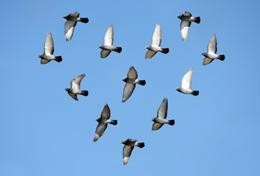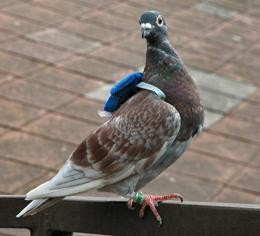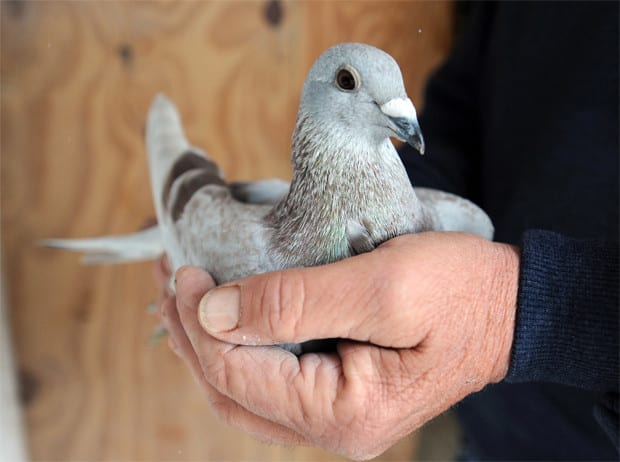
by Pigeon Patrol | Dec 7, 2021 | Bird Spikes, Columbidae, Doves, history of pigeons, MBCA, pet bird, Pigeon Control
Is it dangerous to pick up a bird?
Some birds can bite hard (Northern Cardinals), some can stab (Hairy Woodpeckers), while others can make intimidating noises, But most can’t do any serious damage to a human. Birds do not carry rabies, and are generally at higher risk of catching something from us than vice versa. Wash your hands after handling a bird as a precautionary measure.
But: birds of prey, herons, loons and other birds with strong talons or spear-like beaks can cause serious injury if you do not wear protective gear and take necessary precautions. Please read to the end for specific handling instructions, and do not attempt a rescue if you are not certain you can do so safely.
Two-handed grip for medium-sized birds
Secure the wings by wrapping both your hands around the bird, thumbs on its back, pointing up. Be sure to hold it securely, but be careful not to put pressure on the chest. The bird will instinctively want a place to rest its feet, so let it grab onto your little fingers.
Two-handed grip for small birds
Gently enclose the bird within your hands, leaving room between your fingers to allow the bird to breathe — but not too much room or it will wriggle out.
One-handed grip for small birds
This is similar to the bander’s grip commonly used to stabilize birds for banding (ringing), or to inspect for injuries. Hold the bird’s neck between your index and middle finger while using your thumb and ring finger to secure the wings. Your little finger acts as a perch for the bird’s feet, or you can use your other hand to support the bird from below. If you are not experienced with the bander’s grip, it may be safer to use both hands.
Using a net
A fine-mesh net is often the easiest and safest way to catch a bird. Our volunteers use dollar-store butterfly nets for smaller birds (stick with blue or green nets, avoid red, orange, pink). Nylon fishing nets with large holes are not suitable, as they will not hold a small bird, and risk injuring a larger birds or damaging its feathers.
Gently cover the bird with the net, being careful not to crush the bird’s head, wings or legs with the loop. Hold the net flat against the ground and place one hand over the bird from the outside of the net. Raise the net with that hand, still holding the bird inside the net, and use your other hand to gently extract the bird from the net. Make sure its toes, beak and wings don’t get caught in the netting.
Using a towel, blanket, sweater or jacket
This is usually the easiest way to capture larger birds. Just drop the towel or other piece of fabric over the bird from above, completely covering it. If you cannot cover the whole bird, make sure the head and the wings are covered. Now, just scoop it up in the towel using both hands to ensure that the wings are tucked in.
The towel technique is best for Mourning Doves, because they can shed their feathers to escape, leaving you with a handful of feathers but no bird.
Now what?
Once you have the bird in hand or in a towel or similar, transfer it to a box or, for smaller birds, a plain paper bag, and close the top so the bird cannot escape. The bird may try to fly away even if it badly injured, so please don’t let it. A paper bag does not require air holes, although a box might if it’s airtight.
If you picked up the bird in a towel or similar, make sure its head is uncovered once it’s safely in the box. To do this, or if you need to transfer the bird to another container, please find a small, windowless, enclosed space (e.g. bathroom) so the bird can’t get far if it escapes.
Keep the bird in a dark and quiet place indoors, and do not attempt to give it food or water. Call Safe Wings or another rehabber for further instructions.
Special precautions
Many people worry that birds of prey, such as owls, hawks, falcons and eagles, will bite them. While there’s a very small chance they will, and it can hurt, the real danger lies elsewhere. Raptors have incredibly powerful talons (claws) that they use to grip and kill their prey — and to defend themselves. Do not attempt to handle these birds without thick leather gloves and a thick towel or blanket to protect you from the talons.
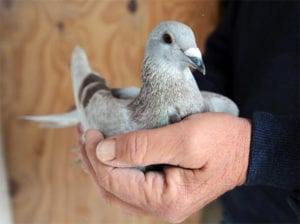
Pigeon in New York City (file / credit: STAN HONDA/AFP/Getty Images)
Never attempt to handle a heron, loon or other bird with a long, spear-like beak without wearing eye protection. They will defend themselves by stabbing at your eyes, which can result in fatal injury. Wearing leather gloves and covering the bird with a thick, large towel or blanket to pick it up will further protect both of you from injury.
In many cases, a sick or injured bird will be too weak to struggle or defend itself. However, a bird in distress may lash out in panic. Please do not attempt to capture a potentially dangerous bird unless you understand and are willing to accept the risks.
Other tips for capturing birds
- Move calmly but deliberately
- Crouch if possible
- Approach from behind, but be mindful not to chase birds towards buildings. (Exception: American Woodcocks should be approached from the front.)
- Act quickly. With the exception of young birds that are learning to fly, almost any wild bird that can be approached needs help.
- Do not wait to see if the bird will fly away. Even badly hurt birds will try to get away if they are in a vulnerable position. Just because they can still fly does not mean they don’t have severe internal injuries.
- Do not mistake helplessness for friendliness. Wild birds are naturally afraid of us (with the exception of young birds that have not yet learned to fear us), so if they appear docile, it’s usually because they have head trauma or another severe injury.
- Stress from excessive handling and noise can kill a bird. Please do not pet an injured bird, sing to it, let your children play with it, or let your dog sniff it. Just get it to a rehabber as quickly and as quietly as possible.
Source
Pigeon Patrol Products & Services is the leading manufacturer and distributor of bird deterrent (control) products in Canada. Pigeon Patrol products have solved pest bird problems in industrial, commercial, and residential settings since 2000, by using safe and humane bird deterrents with only bird and animal friendly solutions. At Pigeon Patrol, we manufacture and offer a variety of bird deterrents, ranging from Ultra-flex Bird Spikes with UV protection, Bird Netting, 4-S Bird Gel and the best Ultrasonic and audible sound devices on the market today.
Voted Best Canadian wholesaler for Bird Deterrent products ten years in a row.
Contact us at 1- 877– 4– NO-BIRD, (604) 585-9279 or visit our website at www.pigeonpatrol.ca
Pigeon/Pigeon Patrol / Pigeons Roosting / Vancouver Pigeon Control /Bird Spikes / Bird Control / Bird Deterrent / Pigeon Deterrent? Surrey Pigeon Control / Pest /Seagull deterrent / Vancouver Pigeon Blog / Birds Inside Home / Pigeons in the cities / Ice Pigeons/ What to do about pigeons/ sparrows , Damage by Sparrows, How To Keep Raccoons Away, Why Are Raccoons Considered Pests/ De-fence / Pigeon Nesting/ Bird Droppings / Pigeon Dropping/ woodpecker control/ Professional Bird Control Company/ Keep The Birds Away/ Birds/rats/ seagull/pigeon/woodpecker/ dove/sparrow/pidgeon control/pidgeon problem/ pidgeon control/flying rats/ pigeon Problems/ bird netting/bird gel/bird spray/bird nails/ bird guard
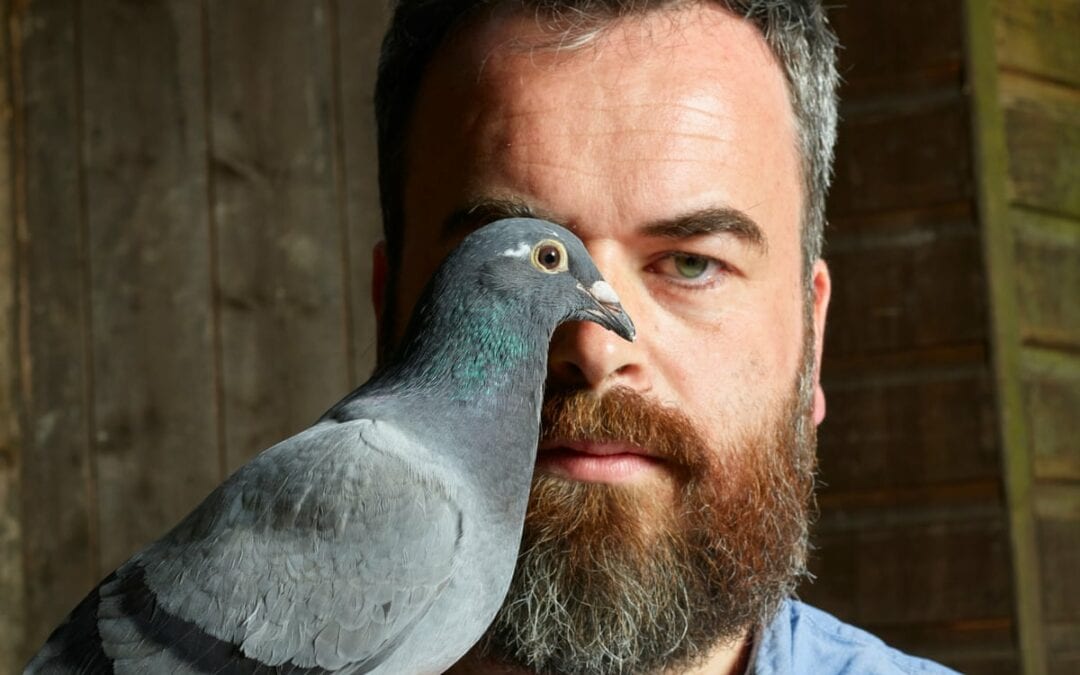
by Pigeon Patrol | Dec 7, 2021 | Columbidae, Doves, history of pigeons, MBCA, pet bird, Pigeon Control
Pigeons—you either love them or hate them. I personally think they are super cute. Have you ever watched a pigeon walking down the street? They look like they’re wearing little knickers. It’s adorable!
What to Do With an Injured Pigeon
The next time you come across an injured pigeon, please think twice about helping it. Before you intervene, you must make sure that your help is really necessary. If it becomes clear that you are the pigeon’s only hope, here are some steps you can take to make sure your response doesn’t make the situation worse:
- Pick up the bird and place it in a box or cage. A cage made for guinea pigs works well.
- Place the cage in a warm, dark area to calm the bird, which is probably very scared and in pain.
- Prepare an electrolyte solution: Warm a cup of water, add a pinch of salt and sugar, and stir to dissolve. When the water is lukewarm, pour it into a deep cup, and offer it to the bird. Pigeons drink water by sucking, using their beaks as a straw.
- Don’t try to feed it at this time. It needs to be rehydrated first.
- If you have a warming pad, place it in the cage or box. Place an old towel over the warming pad and set it on low.
- Check the pigeon for obvious signs of injury: drooping wing, blood, visible cuts.
- If the bird is drinking and seems to be doing okay, you can provide seeds if you have them. Wild bird seed is fine in a pinch. Pigeons love safflower seeds and unpopped popcorn. They can also be fed the smaller millet seed, a basic component in wild bird food.
- If the bird is not eating, he will need immediate help. Pigeons have a high metabolism and need to eat often.
- The Humane Society recommends contacting the closest licensed wildlife rehabilitation center in your area.
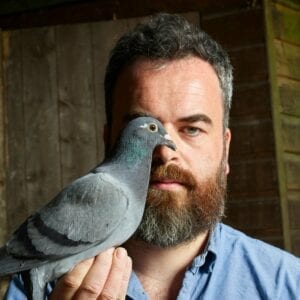
Common Pigeon Injuries
A Pigeon With a Broken Wing
A pigeon with a broken wing is usually unable to fly. Sometimes the wing is drooping or dragging. Occasionally there is blood or protruding bone.
Maybe the pigeon was clipped by a car, had a close encounter with a cat, or high winds threw it against the side of a building. In some cases, a veterinarian can repair the wing, but oftentimes the pigeon will be handicapped for life.
A Pigeon With a Pellet Gun Wound
With this type of wound, you would notice a hole in the pigeon. This wound should be examined for possible infection by a vet. The bird will probably also need antibiotics.
You’ll often see pigeons with mangled feet. They often get tangled in fishing wire or other loose string. This is very dangerous for the pigeon because it can cut circulation to the foot and cause infection.
How to Help Sick or Wounded Pigeons
- Visit The Pigeon Forum to post about your bird. The people on this forum are helpful and can assist you in finding a vet and getting medicine or connect you with a rehabber in your area who can walk you through saving the bird’s life.
- Get in touch with Palomacy Pigeon & Dove Adoptions, an organization that rehabilitates and re-homes injured pigeons, to ask for help.
Do Pigeons Carry Diseases, and Will They Make Me Sick?
Unfortunately, pigeons fall victim to many misconceptions and misinformation. Many believe, for instance, that pigeons carry diseases that are communicable to humans. This is simply untrue according to Nicole Benson, an animal advocate who has rescued dozens of pigeons and has never come down with a disease.
“These misconceptions are put out there by pest control companies who want your business,” she says. “While there are a few diseases that a pigeon may carry (such as salmonella), it is far more likely that we will infect a pigeon with one of the diseases that we carry.”
What Should You Do If You Find a Baby Pigeon?
Tending a baby bird is not an easy task. Like any newborn, a baby pigeon will need a lot of help. Don’t immediately pick up the bird and assume that you can figure out what to do. It’s best for the bird if you enlist the help of experts. In this situation, the Humane Society recommends contacting the closest licensed wildlife rehabilitation center. If you find a baby bird outside its nest, read What to Do If You Find a Baby Bird—Helping Wildlife for more information.
What If the Pigeon Dies?
Don’t be discouraged if you take a pigeon into your care, but you’re unable to save the bird’s life. Not all pigeons can be saved. You did your best by providing the pigeon with a safe, warm place.
Why Are There Suddenly So Many Pigeons?
If you are flummoxed by an increase in pigeons around your home, don’t take drastic measures like hiring an exterminator or using a pellet gun. The birds’ sudden arrival is most likely the result of an increase in food. Once the source of food is eliminated, the pigeons will leave. One solution for keeping pigeons at bay involves putting a reflective material that will move with the breeze on your roof. The motion and reflection will discourage the birds from landing.
Should I Glue Cowboy Hats to Pigeons’ Heads?
The internet is enamored by a video meme featuring pigeons in cowboy hats. The ruggedly handsome birds first showed up on the mean streets of Las Vegas during National Finals Rodeo. It may sound like a funny visual, but it’s also a cruel prank. Pigeon advocate Mariah Hillman told Audubon magazine the hats were inhumanely glued to the pigeons’ heads. The hats also likely impaired the birds’ 340-degree field of view, making it difficult to navigate their surroundings and fly.
Source
Pigeon Patrol Products & Services is the leading manufacturer and distributor of bird deterrent (control) products in Canada. Pigeon Patrol products have solved pest bird problems in industrial, commercial, and residential settings since 2000, by using safe and humane bird deterrents with only bird and animal friendly solutions. At Pigeon Patrol, we manufacture and offer a variety of bird deterrents, ranging from Ultra-flex Bird Spikes with UV protection, Bird Netting, 4-S Bird Gel and the best Ultrasonic and audible sound devices on the market today.
Voted Best Canadian wholesaler for Bird Deterrent products ten years in a row.
Contact us at 1- 877– 4– NO-BIRD, (604) 585-9279 or visit our website at www.pigeonpatrol.ca
Pigeon/Pigeon Patrol / Pigeons Roosting / Vancouver Pigeon Control /Bird Spikes / Bird Control / Bird Deterrent / Pigeon Deterrent? Surrey Pigeon Control / Pest /Seagull deterrent / Vancouver Pigeon Blog / Birds Inside Home / Pigeons in the cities / Ice Pigeons/ What to do about pigeons/ sparrows , Damage by Sparrows, How To Keep Raccoons Away, Why Are Raccoons Considered Pests/ De-fence / Pigeon Nesting/ Bird Droppings / Pigeon Dropping/ woodpecker control/ Professional Bird Control Company/ Keep The Birds Away/ Birds/rats/ seagull/pigeon/woodpecker/ dove/sparrow/pidgeon control/pidgeon problem/ pidgeon control/flying rats/ pigeon Problems/ bird netting/bird gel/bird spray/bird nails/ bird guard
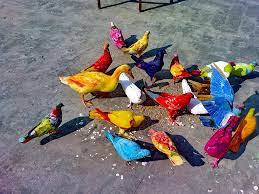
by Pigeon Patrol | Dec 7, 2021 | Columbidae, Doves, history of pigeons, MBCA, pet bird
I remember the first time I saw Tina Piña Trachtenburg (aka Mother Pigeon) and her soft-sculptures of pigeons. I was enthusiastically starting work at More Art, a non-profit arts organization producing socially engaged public art exhibitions and educational activism throughout New York City. Walking by Piña Trachtenburg’s flock of stuffed pigeons artfully arranged on the cobblestone pavement of Union Square, was a very apt beginning to working with an organization developing public art and educational programs aimed at facilitating thought provoking responses to social, cultural and environmental concerns. All of the aforementioned issues are playfully addressed in Piña Trachtenburg’s multidisciplinary street art installation (she calls it an ‘outstallation’ due to her work being displayed outdoors). The pigeon is arguably New York City’s official unofficial bird, and the people of New York City generally have a love/hate relationship with these stout-bodied avians. Piña Trachtenburg’s realistically arranged grouping of pigeons seeks to raise awareness and empathy for these oft-misunderstood birds; and makes connections between natural and synthetic materials that shape and envelop our culture. Through her pigeon influenced pedagogy, we can learn about ourselves, our neighbors and the environment at large.
Pigeons taught Piña Trachtenburg about urban ecology. Studying and interacting with them on her Brooklyn rooftop became an experiential learning process. She even developed a bond with the birds she encountered and shared space with every day. This relationship and awareness led to her creating her coterie of soft-sculpture pigeons utilizing locally sourced materials such as recycled clothes for stuffing the bodies, wire for their feed and various colored acrylic fabric to represent their plumage. Her vibrant pigeon sculptures represent the different characteristics of the real pigeons she observes throughout the city. As for why pigeons make great artistic muses, she implores us to “Look at a pigeon the same way that you would look at a rose, or a bed of wild flowers. They are beautiful and unique, with each one being different from the rest. It is a privilege to have them around us.”

Piña Trachtenburg’s statement is similar to Georgia O’Keefe’s reasoning for devoting her aesthetic career to painting flowers, “When you take a flower in your hand and really look at it, it’s your world for the moment. I want to give that world to someone else. Most people in the city rush around, so they have no time to look at a flower. I want them to see it whether they want to or not.”
One of the habits of mind we employ through art is noticing deeply (see: Educating Through Art), and Piña Trachtenburg’s work is effective for stopping us in our tracks, as well as inspiring our sense of inquiry (another habit of mind). Through performances with her pigeon sculptures, such as musical puppet shows, she communicates uplifting messages about the importance of caring for our surroundings. Her daily actions are documented through her Instagram, where she posts about interactions she has with her fellow humans and pigeons alike. She also discusses issues that affect our urban ecosystems, which include pollution, lack of affordable housing and the need to create safe spaces for all living creatures. Through her online and physical presence, Piña Trachtenburg advocates for us to love and respect our common feathered friends and even the rats, New York City’s other most oft-misunderstood and reviled wildlife species.
Piña Trachtenburg’s interdisciplinary approach of integrating natural and social sciences with the humanities (art, music, spirituality and performance), provides a holistic, down-to-earth perspective for environmental art education. Her multifaceted practice of making public art, performing and educating about ecological issues, highlights the role of art in regards to problem solving and taking action to improve our relationship with our natural surroundings. As a result of viewing and participating in her aesthetic world, we formulate a deeper and more fulfilling understanding of environmental issues that affect our city. We also develop the passion and rationale to make ethical and informed decisions in response to these issues.
In an episode on the podcast Stories Your Granny Never Told, Piña Trachtenburg whimsically describes her practice as a “pigeon religion.” While she was half joking (listen to the podcast episode to learn the context behind this remark), it does feel like she is creating both a sanctuary and doctrine for the moral and compassionate treatment of her feathered friends, and all living things by extension. By forming a humane relationship with pigeons, Piña Trachtenburg has made strides that benefit the social, emotional and physical wellbeing of avian and human alike.
In her recent pandemic-era outstallations, a hand painted sign reads “run for your lives! Humans are spreading disease.” A clear statement that humankind’s actions have direct implications on natural disasters, such as pandemics, which can be linked to our collective contributions to climate change (see: Coronavirus and Climate Change).
Art has a foundational role in spreading awareness and eliciting strong emotional responses around the poignancy of our current ecological crises. Prior works of art like Mel Chins’ Revival Fields (see: Activating Art and Education for Activism) and Michael Wang’s Extinct in New York (see: Back to Nature), stress the importance of protecting and nurturing our natural resources and habitats. They also signify how art and artistic thinking (using the habits of mind) can benefit natural and applied sciences. Piña Trachtenburg’s public facing art is accessible to even larger audiences because she exists in a realm outside of the traditional art or science industries. Her decision to work solely within a heavily trafficked plaza, ensures that people of all walks of life will interact with her eye-catching work.
From the public’s inquiries, discourses and responses to Piña Trachtenburg’s pigeon-centered outstallations, there are reasons for optimism around tangible social, cultural and environmental change. Taking heed of the environmentally conscious messages of ecological artworks might inspire significant emotional responses and further explorations, insights and actions that have positive implications on our relationship to our natural world. It has certainly transformed the moral and ethical choices in my life, especially how I consume and also produce within a materials based art and educational practice. I also have a long-lasting interest in scientific discoveries and research because of art-centered initiatives around natural phenomena, and I would proudly proclaim to be a convert of the pigeon religion.
Source
Pigeon Patrol Products & Services is the leading manufacturer and distributor of bird deterrent (control) products in Canada. Pigeon Patrol products have solved pest bird problems in industrial, commercial, and residential settings since 2000, by using safe and humane bird deterrents with only bird and animal friendly solutions. At Pigeon Patrol, we manufacture and offer a variety of bird deterrents, ranging from Ultra-flex Bird Spikes with UV protection, Bird Netting, 4-S Bird Gel and the best Ultrasonic and audible sound devices on the market today.
Voted Best Canadian wholesaler for Bird Deterrent products ten years in a row.
Contact us at 1- 877– 4– NO-BIRD, (604) 585-9279 or visit our website at www.pigeonpatrol.ca
Pigeon/Pigeon Patrol / Pigeons Roosting / Vancouver Pigeon Control /Bird Spikes / Bird Control / Bird Deterrent / Pigeon Deterrent? Surrey Pigeon Control / Pest /Seagull deterrent / Vancouver Pigeon Blog / Birds Inside Home / Pigeons in the cities / Ice Pigeons/ What to do about pigeons/ sparrows , Damage by Sparrows, How To Keep Raccoons Away, Why Are Raccoons Considered Pests/ De-fence / Pigeon Nesting/ Bird Droppings / Pigeon Dropping/ woodpecker control/ Professional Bird Control Company/ Keep The Birds Away/ Birds/rats/ seagull/pigeon/woodpecker/ dove/sparrow/pidgeon control/pidgeon problem/ pidgeon control/flying rats/ pigeon Problems/ bird netting/bird gel/bird spray/bird nails/ bird guard
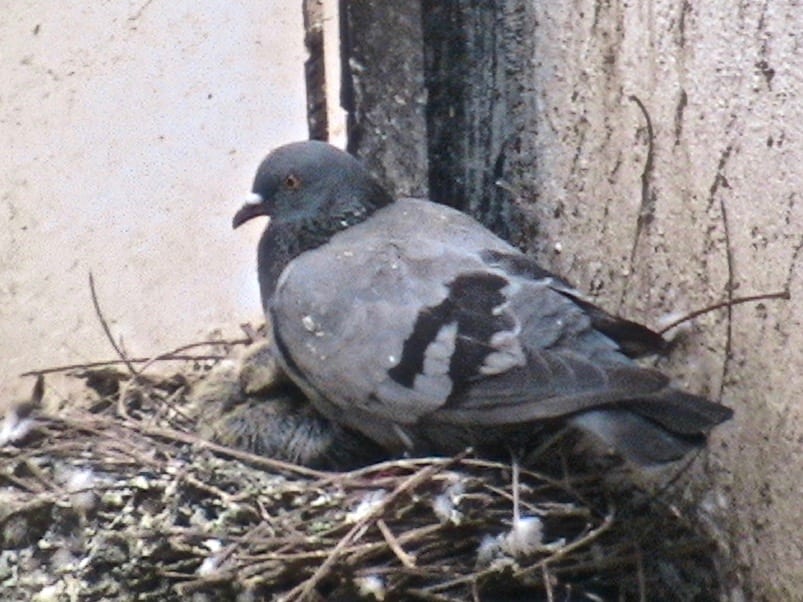
by Pigeon Patrol | Nov 23, 2021 | Bird Deterrent Products, Bird Law, Bird Netting, Bird Spikes, Columbidae, Doves
(PhysOrg.com) — Pigeon flocks are guided by a flexible system of leadership in which almost every member gets a ‘vote’ but the votes of high-ranking birds carry more weight, a new study has shown.
Scientists used GPS ‘backpacks’ to record the flight paths of individual pigeons and then analysed interactions between the birds. Their findings could help us understand the collective behaviour of other animals, including humans.
A report of the research, carried out by scientists from Oxford University and Eötvös University, Hungary, is published in this week’s Nature.
‘We are all aware of the amazing aerobatics performed by flocks of birds but how such flocks decide where to go and whether decisions are made by a dominant leader or by the group as a whole has always been a mystery,’ said Dr Dora Biro of Oxford University’s Department of Zoology, an author of the paper. ‘We found that, whilst most birds have a say in decision-making, a flexible system of ‘rank’ ensures that some birds are more likely to lead and others to follow.’
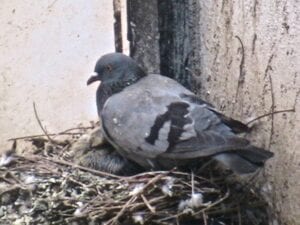
As part of the study, miniature GPS loggers weighing just 16g were fitted into custom-made backpacks carried by flocks of up to 10 homing pigeons. These enabled scientists to, for the first time, explore spatial and temporal relationships between individual birds and the movement decisions they made at the scale of a fraction of a second.
The team measured shifts in the flight direction of each bird every 0.2 seconds and tried to ‘line up’ these changes across different birds in the flock to determine who initiated any given change in direction and who followed (and with what time delay). The research revealed unexpectedly well-defined hierarchies within flocks, with a spectrum of different levels of leadership which in turn determined the influence individuals had on other birds and on the flock as a whole.
‘Crucially, these hierarchies are flexible in the sense that the leading role of any given bird can vary over time, while nonetheless remaining predictable in the long run,’ Dr Biro said. ‘This dynamic, flexible segregation of individuals into leaders and followers – where even the lower-ranking members’ opinions can make a contribution – may represent a particularly efficient form of decision-making.’
‘Whether such effects come from some individuals being more motivated to lead or being inherently better navigators, perhaps with greater navigational knowledge, is an intriguing question we don’t yet have an answer to.’
The team also discovered that a bird’s position in the flock matched its position in the hierarchy, with individuals nearer the front more likely to be responsible for decisions. Additionally, they found that followers responded more quickly to those flying on their left, confirming observations in the laboratory that suggest birds process social information – such as tracking and responding to the movements of other birds – predominantly through input that the brain receives from the left eye.
The researchers believe their findings could help unravel the decision-making process in many other groups of animals. Further studies may reveal how such a sophisticated leadership strategy confers evolutionary advantage on individuals over a strategy based on a single leader or one in which all members contribute equally to decision-making.
Source
Pigeon Patrol Products & Services is the leading manufacturer and distributor of bird deterrent (control) products in Canada. Pigeon Patrol products have solved pest bird problems in industrial, commercial, and residential settings since 2000, by using safe and humane bird deterrents with only bird and animal friendly solutions. At Pigeon Patrol, we manufacture and offer a variety of bird deterrents, ranging from Ultra-flex Bird Spikes with UV protection, Bird Netting, 4-S Bird Gel and the best Ultrasonic and audible sound devices on the market today.
Voted Best Canadian wholesaler for Bird Deterrent products ten years in a row.
Contact us at 1- 877– 4– NO-BIRD, (604) 585-9279 or visit our website at www.pigeonpatrol.ca
Pigeon/Pigeon Patrol / Pigeons Roosting / Vancouver Pigeon Control /Bird Spikes / Bird Control / Bird Deterrent / Pigeon Deterrent? Surrey Pigeon Control / Pest /Seagull deterrent / Vancouver Pigeon Blog / Birds Inside Home / Pigeons in the cities / Ice Pigeons/ What to do about pigeons/ sparrows , Damage by Sparrows, How To Keep Raccoons Away, Why Are Raccoons Considered Pests/ De-fence / Pigeon Nesting/ Bird Droppings / Pigeon Dropping/ woodpecker control/ Professional Bird Control Company/ Keep The Birds Away/ Birds/rats/ seagull/pigeon/woodpecker/ dove/sparrow/pidgeon control/pidgeon problem/ pidgeon control/flying rats/ pigeon Problems/ bird netting/bird gel/bird spray/bird nails/ bird guard
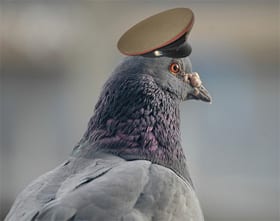
by Pigeon Patrol | Nov 23, 2021 | Columbidae, Doves, history of pigeons, MBCA, pet bird
One of Northern Ireland’s smallest World War II heroes has been honoured.
Paddy, a messenger pigeon who served with the RAF during the Normandy operations in June 1944, was remembered in his home town of Larne on Friday.
PDSA, Britain’s biggest veterinary charity, awarded Paddy the Dickin Medal, dubbed the animals’ “Victoria Cross”, 65 years ago this month.
He received it for being the fastest pigeon to reach England with a coded message from the battle-front beaches of Normandy.
The brave bird brought back vital information about the Allies’ progress, flying 230 miles in four hours 50 minutes – the fastest time of any of the messenger pigeons involved in the mission with an average speed of 56mph.

PDSA spokesman James Puxty said: “Paddy’s contribution to the D-Day operations was a credit to the thousands of messenger pigeons donated by the racing pigeon fraternity for service during World War II.
“He was one of 32 brave, feathered heroes that received the PDSA Dickin Medal for their life-saving flights during the war, and the only recipient from Northern Ireland.”
Local hero
Paddy was born and raised in Carnlough and joined thousands of other racing birds who were trained and drafted to RAF Hurn in Hampshire for military service.
Impressing military brass with his flying in the Air-Sea rescue units he was seconded to the United States First Army for undercover missions during the Normandy Landings.
In the face of poor weather conditions and the threat of German falcons, deployed to intercept Paddy and his comrades, he delivered his message to his home loft at RAF Hurn.
After the war Paddy returned to Carnlough and lived out his days with his owner Captain Andrew Hughes, until his death in 1954.
A memorial to the winged hero was erected in Carnlough harbour.
A feathered fly-past of pigeons formed part of the Paddy Memorial Day event held at Larne Museum and Arts Centre.
Larne Borough Council and the town’s historical society were joined by guests from PDSA and the owner of Paddy’s PDSA Dickin Medal, former Irish Army officer Kevin Spring.
Younger guests were entertained by Gail Seekamp, the children’s author, who read from her book “Paddy the Pigeon”.
The Dickin Medal was introduced in 1943 by Maria Dickin, PDSA’s founder. She wanted to recognise the gallantry and devotion to duty of animals serving with the Armed Forces and Civil Defence units during WWII.
Source
Pigeon Patrol Products & Services is the leading manufacturer and distributor of bird deterrent (control) products in Canada. Pigeon Patrol products have solved pest bird problems in industrial, commercial, and residential settings since 2000, by using safe and humane bird deterrents with only bird and animal friendly solutions. At Pigeon Patrol, we manufacture and offer a variety of bird deterrents, ranging from Ultra-flex Bird Spikes with UV protection, Bird Netting, 4-S Bird Gel and the best Ultrasonic and audible sound devices on the market today.
Voted Best Canadian wholesaler for Bird Deterrent products ten years in a row.
Contact us at 1- 877– 4– NO-BIRD, (604) 585-9279 or visit our website at www.pigeonpatrol.ca
Pigeon/Pigeon Patrol / Pigeons Roosting / Vancouver Pigeon Control /Bird Spikes / Bird Control / Bird Deterrent / Pigeon Deterrent? Surrey Pigeon Control / Pest /Seagull deterrent / Vancouver Pigeon Blog / Birds Inside Home / Pigeons in the cities / Ice Pigeons/ What to do about pigeons/ sparrows , Damage by Sparrows, How To Keep Raccoons Away, Why Are Raccoons Considered Pests/ De-fence / Pigeon Nesting/ Bird Droppings / Pigeon Dropping/ woodpecker control/ Professional Bird Control Company/ Keep The Birds Away/ Birds/rats/ seagull/pigeon/woodpecker/ dove/sparrow/pidgeon control/pidgeon problem/ pidgeon control/flying rats/ pigeon Problems/ bird netting/bird gel/bird spray/bird nails/ bird guard
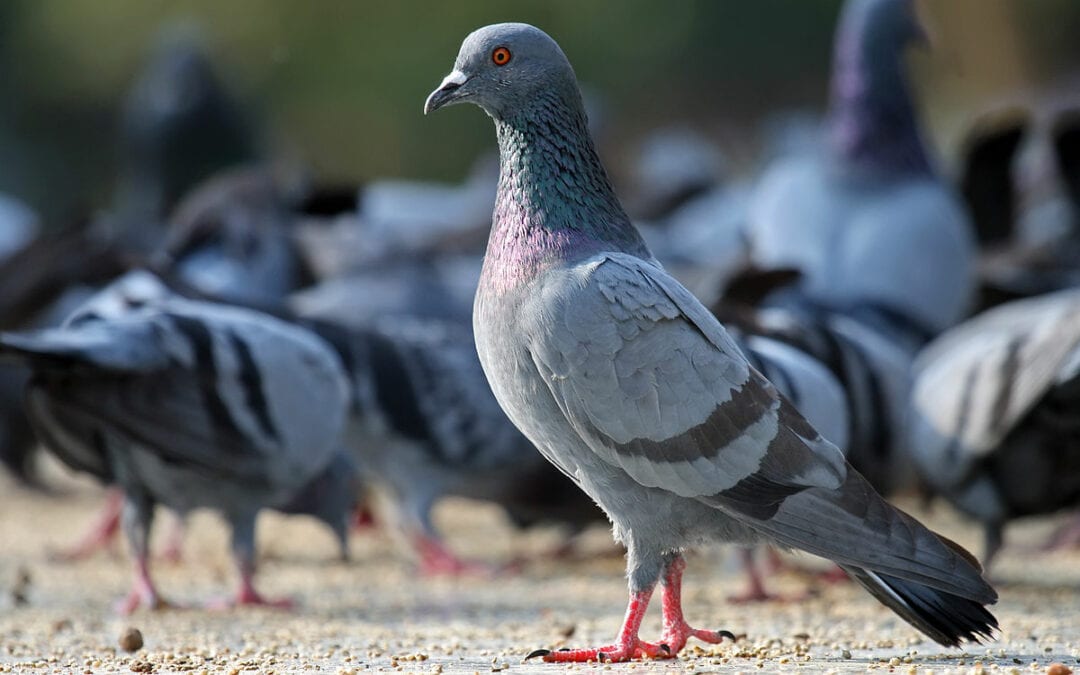
by Pigeon Patrol | Nov 16, 2021 | Bird Netting, Bird Spikes, Columbidae, Doves, history of pigeons, MBCA
During flight, pigeons in a flock follow the leader.
Pigeons wearing miniature backpacks containing tracking devices have revealed that the birds rapidly shift direction during flight in response to cues from the leading members of their group.
“It is the first study demonstrating hierarchical decision-making in a group of free-flying birds,” says Tamás Vicsek, a biophysicist at Eötvös Loránd University in Budapest who led the study, which is published today in Nature1.
The discovery became possible only recently with the introduction of Global Positioning System (GPS) devices that can collect data at a high rate: five times per second. Vicsek’s team strapped lightweight GPS devices to individual pigeons and tracked flocks of up to 10 birds during free flights lasting around 12 minutes and 15-kilometre homing flights. In total, the GPS logged 32 hours of data and captured 15 group flights. The researchers couldn’t pinpoint individuals’ exact positions within a flock, but were able to accurately compare birds’ directions of motion.
Within flocks, the authors looked first at the behaviour of pairs of birds. For each possible pairing, the team identified a leader — the bird that changed direction first — and a follower, which copied the leader’s motion. Followers reacted very quickly, within a fraction of a second.
Next, the scientists constructed a network of relationships among birds in the group during each flight. They uncovered a robust pecking order: birds higher up the ranks had more influence over the group’s movements, and each individual’s level of influence was consistent across specific free and homing flights.
However, this influence was not always consistent between flights, with some rearrangement occurring among birds at the head of the flock. Vicsek speculates that this may have occurred because an original leader had tired. Co-author Dora Biro, an animal behaviour expert at the University of Oxford, UK, says, “This kind of group decision-making is more complicated than previous models suggested.”
Although pigeons have an almost 340º field of view, the researchers found that the birds at the front of a flock tended to make the navigational decisions. Moreover, birds responded more readily to a leader’s movements if the leader was on their left side. These findings concur with previous work that indicated that social cues entering a bird’s left eye receive preferential processing in the brain2.
“No other study has contributed more to our understanding of collective decision-making in actively homing animals, not by a long shot,” says Todd Dennis, an expert in pigeon navigation at the University of Auckland in New Zealand. He likens the birds’ group behaviour to that of a cabaret dance troupe, in which less-experienced dancers towards the rear correct themselves by watching experts at the front. “The study provides a very important model for how collective behaviour and leadership can be assessed in a range of animal groups,” he says.
The authors say that a hierarchical arrangement may foster more flexible and efficient decision-making compared with that of singly led or egalitarian groups. In future studies, the scientists plan to investigate whether leaders are better navigators, and whether hierarchies persist in larger groups and in other types of social animal. “If it’s true that there’s an evolutionary advantage to making decisions in this way, then there’s absolutely a reason to assume that it could have evolved in other species too,” Biro says.
Source
Pigeon Patrol Products & Services is the leading manufacturer and distributor of bird deterrent (control) products in Canada. Pigeon Patrol products have solved pest bird problems in industrial, commercial, and residential settings since 2000, by using safe and humane bird deterrents with only bird and animal friendly solutions. At Pigeon Patrol, we manufacture and offer a variety of bird deterrents, ranging from Ultra-flex Bird Spikes with UV protection, Bird Netting, 4-S Bird Gel and the best Ultrasonic and audible sound devices on the market today.
Voted Best Canadian wholesaler for Bird Deterrent products ten years in a row.
Contact us at 1- 877– 4– NO-BIRD, (604) 585-9279 or visit our website at www.pigeonpatrol.ca
Pigeon/Pigeon Patrol / Pigeons Roosting / Vancouver Pigeon Control /Bird Spikes / Bird Control / Bird Deterrent / Pigeon Deterrent? Surrey Pigeon Control / Pest /Seagull deterrent / Vancouver Pigeon Blog / Birds Inside Home / Pigeons in the cities / Ice Pigeons/ What to do about pigeons/ sparrows , Damage by Sparrows, How To Keep Raccoons Away, Why Are Raccoons Considered Pests/ De-fence / Pigeon Nesting/ Bird Droppings / Pigeon Dropping/ woodpecker control/ Professional Bird Control Company/ Keep The Birds Away/ Birds/rats/ seagull/pigeon/woodpecker/ dove/sparrow/pidgeon control/pidgeon problem/ pidgeon control/flying rats/ pigeon Problems/ bird netting/bird gel/bird spray/bird nails/ bird guard










